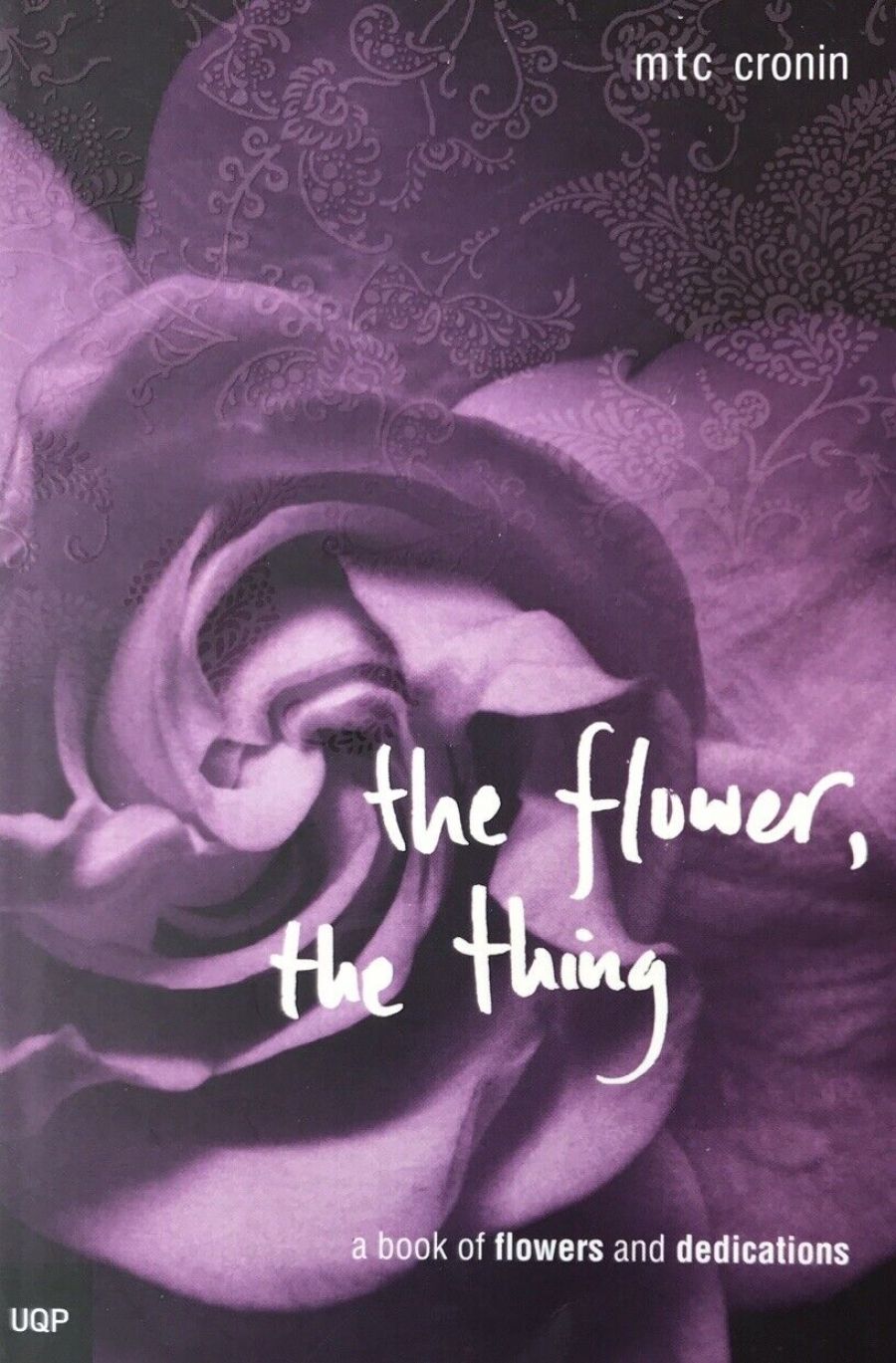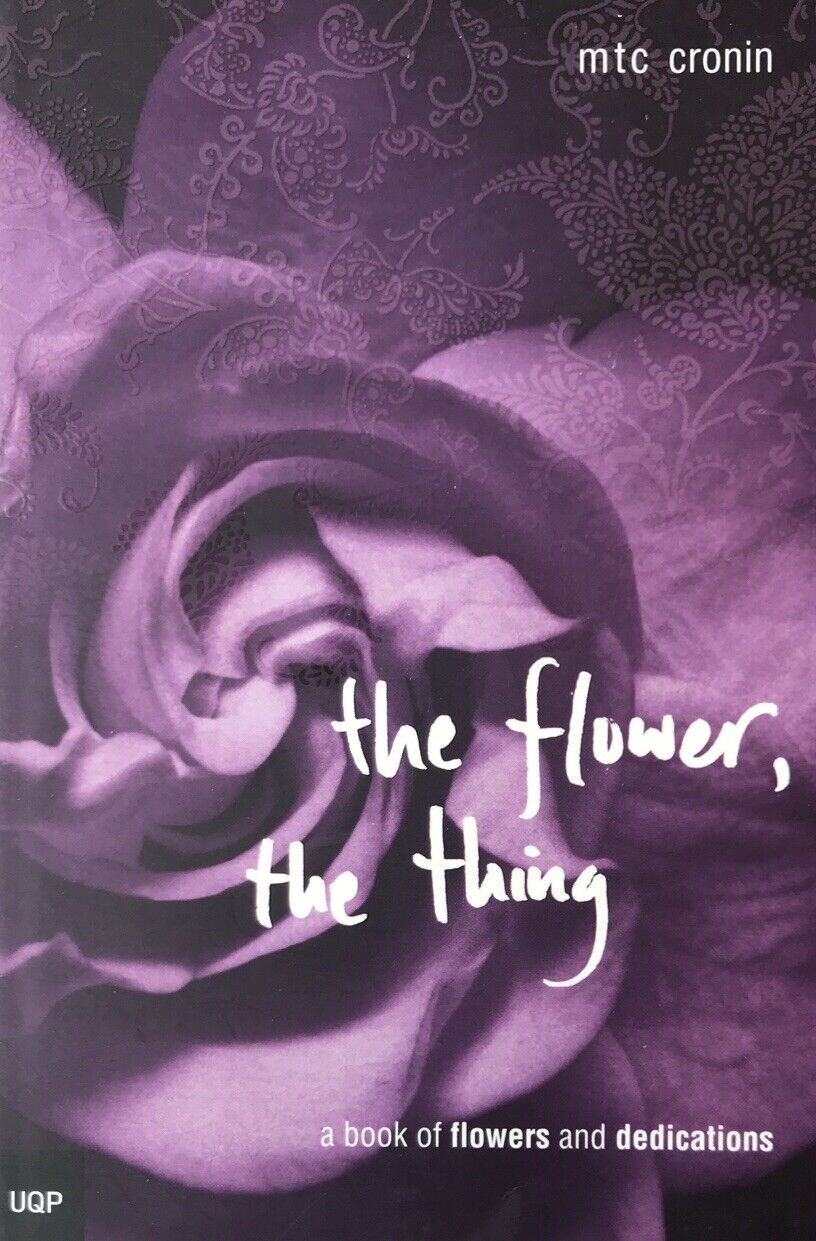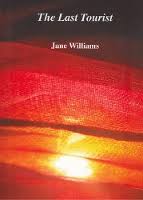
- Free Article: No
- Contents Category: Poetry
- Review Article: Yes
- Article Title: Tides of loss
- Online Only: No
- Custom Highlight Text:
What shapes might poets use to house and craft their various perceptions? Given the absence of a narrative framework, particularly within lyric poetry, what are the possible images and contents through which poetry might weave its insights, and thereby build a tangible structure able to communicate the ephemera of experience and idea? In her most recent collection of poems, M.T.C. Cronin, surely one of the most significant poets writing in Australia today, works explicitly within the artifice of a given structure – a series of poems, titled for alphabetically organised flowers, each with its own specific dedication.
- Book 1 Title: The Flower, The Thing
- Book 1 Biblio: UQP, $22.95 pb, 122 pp
- Book 1 Cover Small (400 x 600):

- Book 1 Cover (800 x 1200):

- Book 2 Title: The Last Tourist
- Book 2 Biblio: Five Islands Press, $18.95 pb, 90 pp
- Book 2 Cover Small (400 x 600):

- Book 2 Cover (800 x 1200):

The possibilities for flowers range from ‘Azaleas’ to ‘Mayflowers, Hyacinth and Dead Anemone’ to ‘Nameless Flower’ and ‘Tree’; the dedications from luminaries such as Maurice Merleau-Ponty or Marcel Proust, to other poets such as Paul Celan, Judith Beveridge and Walt Whitman, as well as to relatives and friends. Like the poems in her earlier book <More or Less Than> 1–100 (2004), this structure, so evocative of the conventions of the floral tribute, provides Cronin with a skeletal frame from which to wander, linking the disparate perceptions and even styles in an aesthetic of the rambling garden, the eclectic bunch of flowers. In this way, the poems can be seen to operate like gifts – gifts of acknowledgment, of tribute and genealogy, of articulation of the threads of intimacy and reciprocal connection. Like all gifts, these poems are offerings that speak both of the recipient who has somehow inspired or earned this recognition, and of the giver, the poet whose own words gather and arrange varied blooms in inventive response. So, in the poem ‘Brains-Bloom’, the rich brevity of Cronin’s language both echoes and pays tribute to the density, pain and ultimate generosity of that poet’s voice:
Your hand the leaf,
heart-leaves,
worldgathering,
shaping search to
hunger, holding, hold-
ing to now –
water soil air light-
forming, brave, last-
ing; finally
growing into grief.
By contrast, the poem ‘Sweet Violets’ speaks of the intimacy of connection with her child, whose ‘blue eyes are the tiniest whales / ever to displace a sea’. The observing voice in the poem here weaves a series of images that entwine sea and land, fluidity and a place to stand and grow in soil. The collection’s final poem challenges us both to look and to interpret – ‘Urgently, now, before us, the flower, the thing’. With this exhortation, Cronin confronts the philosophical and aesthetic crux of poetic praxis: to what extent does the poem reflect interior experience, and to what extent does it illuminate an exterior world? The image of the flower – varied, multifaceted, transient yet recurring, emblematic of loss and of return – is used to embody the crucial axis of perception, where the world of external beauty and specificity must inevitably be coloured by the point of perception, by the shaping powers of the poetic imagination.
In her second book of poetry, Jane Williams uses the broad motifs of travel and different forms of transition – and indeed the reflective writings that travel can facilitate – to offer us a path through different vistas of experience. The Last Tourist takes the reader across a number of borders and boundaries – of geographical place and culture, the past and the present, love and its possibilities, and the irrevocable tides of loss. In the poem ‘Dear Dave’, presumably the lost brother to whom the book is dedicated, the poet chronicles both what is mourned and the ambivalent residue of what remains: ‘there is hope – that bone in the throat soft enough to swallow. / I dip into your journals and find clues on travelling alone.’
On the brink of the articulations of the poet, the traveller also faces the urgency of the ‘thing’, the world that is knowable only through the slippery point of perception. As the poem ‘Tips for the Last Tourist’ suggests, the poet/traveller is always alone, always undertaking some kind of quest in which ‘the search for home / suspends itself unchallenged / between the last tourist and the last ferry missed / half on purpose’. In this swinging hiatus between home and elsewhere, when the ‘strange land’ becomes more than the passive site of the tourist gaze, the last tourist is perhaps freer to look again: ‘Examine yourself against your lack of definition – / your desire to possess the nose / eyes / mouth / tongue of another.’
In ‘My Mother’s Travel Diary’, which ‘begins with murder / and ends in the year of my birth’, travel itself is the hiatus, the youthful circumnavigation of elsewhereness – ‘To ensnare hearts in every country. / Never die not knowing’ – which will inevitably return to the port of departure, both the same and yet unalterably changed. While the ‘bound and zipped’ journal seems to represent an ultimate closure, like a ‘body bagged after the soul’s great escape’, the movement of travel has also yielded more than could have been imagined, a wandering of the imagination that can open as well as close. Not only are the peaks and troughs of drama and adventure memorialised in the processes of recollection, but so too are the possibilities of future, the as-yet unwritten pages of the life of the poet-speaker, inscribed in invisible ink in the palimpsest of that last, meandering tourist.


Comments powered by CComment